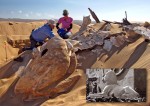 The remains of a large plaster sphinx made for Cecil B. DeMille’s 1923 silent epic The Ten Commandments have been recovered from the sands of Guadalupe-Nipomo Dunes near Pismo Beach, California. It is one of 21 hollow plaster sphinxes, each 12 feet tall and weighing five tons, used to line the boulevard leading to the main gates of “The City of the Pharaoh,” an imposing visual borrowed from the Boulevard of Sphinxes at Luxor Temple.
The remains of a large plaster sphinx made for Cecil B. DeMille’s 1923 silent epic The Ten Commandments have been recovered from the sands of Guadalupe-Nipomo Dunes near Pismo Beach, California. It is one of 21 hollow plaster sphinxes, each 12 feet tall and weighing five tons, used to line the boulevard leading to the main gates of “The City of the Pharaoh,” an imposing visual borrowed from the Boulevard of Sphinxes at Luxor Temple.
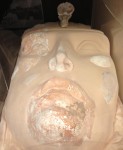 An excavation in 2012 recovered the head of one of the boulevard sphinxes, but the team didn’t have the time to recover the body at that time. They buried the body in sand hoping to protect it until they returned, but the elements were unmerciful and when they returned this year the body was in pieces. They found another body nearby, however, that was in much better condition, but keeping it that way once it was exposed to the air was a challenge.
An excavation in 2012 recovered the head of one of the boulevard sphinxes, but the team didn’t have the time to recover the body at that time. They buried the body in sand hoping to protect it until they returned, but the elements were unmerciful and when they returned this year the body was in pieces. They found another body nearby, however, that was in much better condition, but keeping it that way once it was exposed to the air was a challenge.
The archaeologists planned to protect the sphinx for removal using the same technique that preserves artifacts excavated in the Middle East — coating them with epoxy and a layer of cheese cloth.
But the humidity from a persistent marine layer prevented the epoxy from adhering, Jenzen said, and the crew had to come up with another plan. [..]
The protective process they came up with was to place a sheet of thin plastic over the plaster, then coat it with expanding foam insulation that hardens to protect the fragile pieces while they’re moved.
The improvised system worked and the sphinx was successfully removed for conservation at the Guadalupe-Nipomo Dunes Center.
[youtube=http://youtu.be/PMveQnLtlxk&w=430]
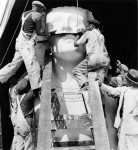 DeMille spared no expense making the set for this Moses vs. Pharaoh epic. He wanted it to look big so he made the biggest set in movie history. The City of the Pharoah set was 720 feet wide, 110 feet tall flanked by four 40-ton statues of Rameses II. The total weight in statuary for the entire movie was 500 tons, which is a particularly astounding weight when you consider that each statue was made of plaster of Paris pieces that could be transported from Los Angeles 175 miles up the coast to the dunes and put together on site. Designed by Art Deco master Paul Iribe, the set took 1,600 craftsmen to build using 500,000 board-feet of lumber, 25,000 pounds of nails, 75 miles of reinforcing cable. There were
DeMille spared no expense making the set for this Moses vs. Pharaoh epic. He wanted it to look big so he made the biggest set in movie history. The City of the Pharoah set was 720 feet wide, 110 feet tall flanked by four 40-ton statues of Rameses II. The total weight in statuary for the entire movie was 500 tons, which is a particularly astounding weight when you consider that each statue was made of plaster of Paris pieces that could be transported from Los Angeles 175 miles up the coast to the dunes and put together on site. Designed by Art Deco master Paul Iribe, the set took 1,600 craftsmen to build using 500,000 board-feet of lumber, 25,000 pounds of nails, 75 miles of reinforcing cable. There were 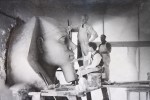 2,500 human extras and 3,000 animals. It cost $1.4 million and made $4 million, a record box office for Paramount that would stand for 22 years until DeMille’s remake of the movie shattered it.
2,500 human extras and 3,000 animals. It cost $1.4 million and made $4 million, a record box office for Paramount that would stand for 22 years until DeMille’s remake of the movie shattered it.
Among the extras were 250 Orthodox Jews who DeMille specifically sought out to give the Exodus scenes authenticity and it was by all accounts an incredibly moving experience.
“These Jews streamed out of the great gates with tears running down their cheeks, and then without prompting or rehearsal, they began singing in Hebrew the old chants of their race, which have been sung in synagogues for thousands of years,” wrote Los Angeles Times reporter Hallett Abend.
According to syndicated Hollywood columnist Jack Jungmeyer, the Jews chanted “Father of Mercy” and “Hear O Israel.” He heard one of the older Jews say to a crew member, “We know this script – our fathers studied it long before there were movies. This is the tale of our beginnings. It is deep in our hearts.”
An elderly woman, overcome with emotion, fell to her knees and shook a fist at the gates of Pharaoh, weeping and casting sand on her head.
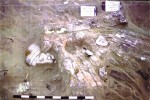 Legend has it that when the shooting was over, DeMille had his glorious set dynamited so no budget production could run over to the Guadalupe-Nipomo Dunes and reuse his masterpiece, but archaeologists have found no evidence of wholesale destruction. The set was dismantled and buried in the sand and now nearly a hundred years later, it has been eroded away by sun, sand and rain. For 60 years the exact location of the set was lost until in 1983 filmmaker Peter Brosnan found the “Lost City of Cecil B. DeMille,” as it had become known, going on a clue in DeMille’s posthumous autobiography and tips from extras on the film who were still living.
Legend has it that when the shooting was over, DeMille had his glorious set dynamited so no budget production could run over to the Guadalupe-Nipomo Dunes and reuse his masterpiece, but archaeologists have found no evidence of wholesale destruction. The set was dismantled and buried in the sand and now nearly a hundred years later, it has been eroded away by sun, sand and rain. For 60 years the exact location of the set was lost until in 1983 filmmaker Peter Brosnan found the “Lost City of Cecil B. DeMille,” as it had become known, going on a clue in DeMille’s posthumous autobiography and tips from extras on the film who were still living.
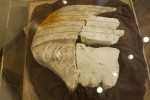 In 1998, Brosnan’s organization, Friends of the Lost City, began to collaborate with the Guadalupe-Nipomo Dunes Center, then the Nature Conservancy, to excavate and preserve the set. The found pieces of the set as well as artifacts left behind by the cast and crew, putting them on display in what is today the Dunes Center.
In 1998, Brosnan’s organization, Friends of the Lost City, began to collaborate with the Guadalupe-Nipomo Dunes Center, then the Nature Conservancy, to excavate and preserve the set. The found pieces of the set as well as artifacts left behind by the cast and crew, putting them on display in what is today the Dunes Center.
The sphinx head recovered in 2012 has been conserved as is now part the star of the Dunes Center Lost City exhibition. Once the newly recovered sphinx body has been reconstructed next year, it will go on display with the head of its companion.